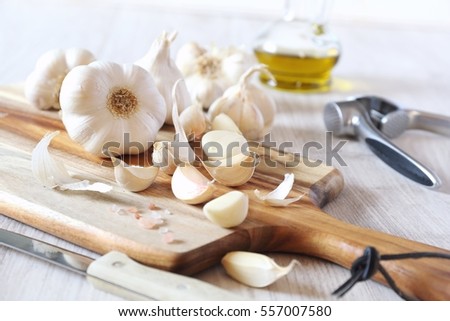Dr. Mercola says, leaving the outer wrapping on garlic will inhibit sprouting and prevent rotting, allowing you to store the garlic longer. As a general rule, hardneck varieties will stay fresh for four to six months if stored in a cool, dry place. Softneck varieties can be stored for up to eight months or longer. For even more extended storage, you can process it in various ways:
Dehydrating: Using a dehydrator (not your oven, as heat will damage beneficial compounds) will stop the loss of moisture that naturally occurs as soon as you harvest the garlic. As moisture is lost, it gets hotter and more pungent. Dehydrating it will stop this process, preserving the garlic at whatever level of flavor it currently has.
To dehydrate garlic, make sure the cloves are firm and clean. Slice them evenly and dehydrate at 110 to 116 degrees F until completely dry. Drying time will depend on the thickness of the slices. The thinner they are, the quicker they dry. A food processor with a feed tube attachment can be helpful for creating slices of even thickness.
Store in a tightly sealed container with a desiccant to soak up any moisture! The chips can then be used in an adjustable grinder, or chopped and used in soups, chili and roasts, for example.
Pickling: While pickling will extend the usefulness of the garlic more or less indefinitely, it does alter the nature of the compounds in the garlic, neutralizing some and creating others. Hence, pickled garlic has different medicinal qualities than raw.
As explained by Enon Valley Garlic Company: "The acid in vinegar neutralizes the alliinase and slowly breaks down the rest of the cloves into odorless, water-soluble compounds that circulate via the bloodstream, mostly S-allyl cysteine (SAC), the active ingredient in Kyolic brand of aged garlic extract.
Kyolic has many studies demonstrating that SAC lowers cholesterol, blood pressure and sugar levels as well as inhibiting platelet aggregation. While SAC may have some anti-tumor properties, the odorous sulfides have far greater anticancer properties … The longer you leave the garlic in the vinegar, the more SAC is formed — for two to three years; it just gets better with age."
To pickle your garlic, clean it as you would if you were eating it raw and place in a sterile glass jar. Cover the cloves completely with 5 percent vinegar (white vinegar, apple cider vinegar or live mother vinegar). Cap with a lid and refrigerate for at least two months. Again, the longer you leave it, the better. Both the garlic cloves and the vinegar solution can be consumed, and will have the same medicinal qualities.
Preserving: The process of preservation is similar to pickling, but will not extend shelf life for years on end. You can, however, get at least a year out of it if it's stored in the refrigerator. Prepare the garlic as described under pickling, but instead of using full-strength vinegar, simply cover the cloves with distilled water and add 1 tablespoon of vinegar per quart of water. You can use more, but not less vinegar than this. By lowering the pH, spoilage is prevented.
Freezing: Yes, garlic can also be frozen for up to three years, but it's uncertain as to whether it's best to freeze it whole, or chop or crush it first. Enon Valley recommends crushing or chopping the garlic and then waiting five to 20 minutes before freezing it to optimize the possibility of having the allicin and sulfide formation occur upon thawing.
Article Source: mercola.com
Dehydrating: Using a dehydrator (not your oven, as heat will damage beneficial compounds) will stop the loss of moisture that naturally occurs as soon as you harvest the garlic. As moisture is lost, it gets hotter and more pungent. Dehydrating it will stop this process, preserving the garlic at whatever level of flavor it currently has.
To dehydrate garlic, make sure the cloves are firm and clean. Slice them evenly and dehydrate at 110 to 116 degrees F until completely dry. Drying time will depend on the thickness of the slices. The thinner they are, the quicker they dry. A food processor with a feed tube attachment can be helpful for creating slices of even thickness.
Store in a tightly sealed container with a desiccant to soak up any moisture! The chips can then be used in an adjustable grinder, or chopped and used in soups, chili and roasts, for example.
Pickling: While pickling will extend the usefulness of the garlic more or less indefinitely, it does alter the nature of the compounds in the garlic, neutralizing some and creating others. Hence, pickled garlic has different medicinal qualities than raw.
As explained by Enon Valley Garlic Company: "The acid in vinegar neutralizes the alliinase and slowly breaks down the rest of the cloves into odorless, water-soluble compounds that circulate via the bloodstream, mostly S-allyl cysteine (SAC), the active ingredient in Kyolic brand of aged garlic extract.
Kyolic has many studies demonstrating that SAC lowers cholesterol, blood pressure and sugar levels as well as inhibiting platelet aggregation. While SAC may have some anti-tumor properties, the odorous sulfides have far greater anticancer properties … The longer you leave the garlic in the vinegar, the more SAC is formed — for two to three years; it just gets better with age."
To pickle your garlic, clean it as you would if you were eating it raw and place in a sterile glass jar. Cover the cloves completely with 5 percent vinegar (white vinegar, apple cider vinegar or live mother vinegar). Cap with a lid and refrigerate for at least two months. Again, the longer you leave it, the better. Both the garlic cloves and the vinegar solution can be consumed, and will have the same medicinal qualities.
Preserving: The process of preservation is similar to pickling, but will not extend shelf life for years on end. You can, however, get at least a year out of it if it's stored in the refrigerator. Prepare the garlic as described under pickling, but instead of using full-strength vinegar, simply cover the cloves with distilled water and add 1 tablespoon of vinegar per quart of water. You can use more, but not less vinegar than this. By lowering the pH, spoilage is prevented.
Freezing: Yes, garlic can also be frozen for up to three years, but it's uncertain as to whether it's best to freeze it whole, or chop or crush it first. Enon Valley recommends crushing or chopping the garlic and then waiting five to 20 minutes before freezing it to optimize the possibility of having the allicin and sulfide formation occur upon thawing.
Article Source: mercola.com


No comments:
Post a Comment
Please leave a comment. Thank you.